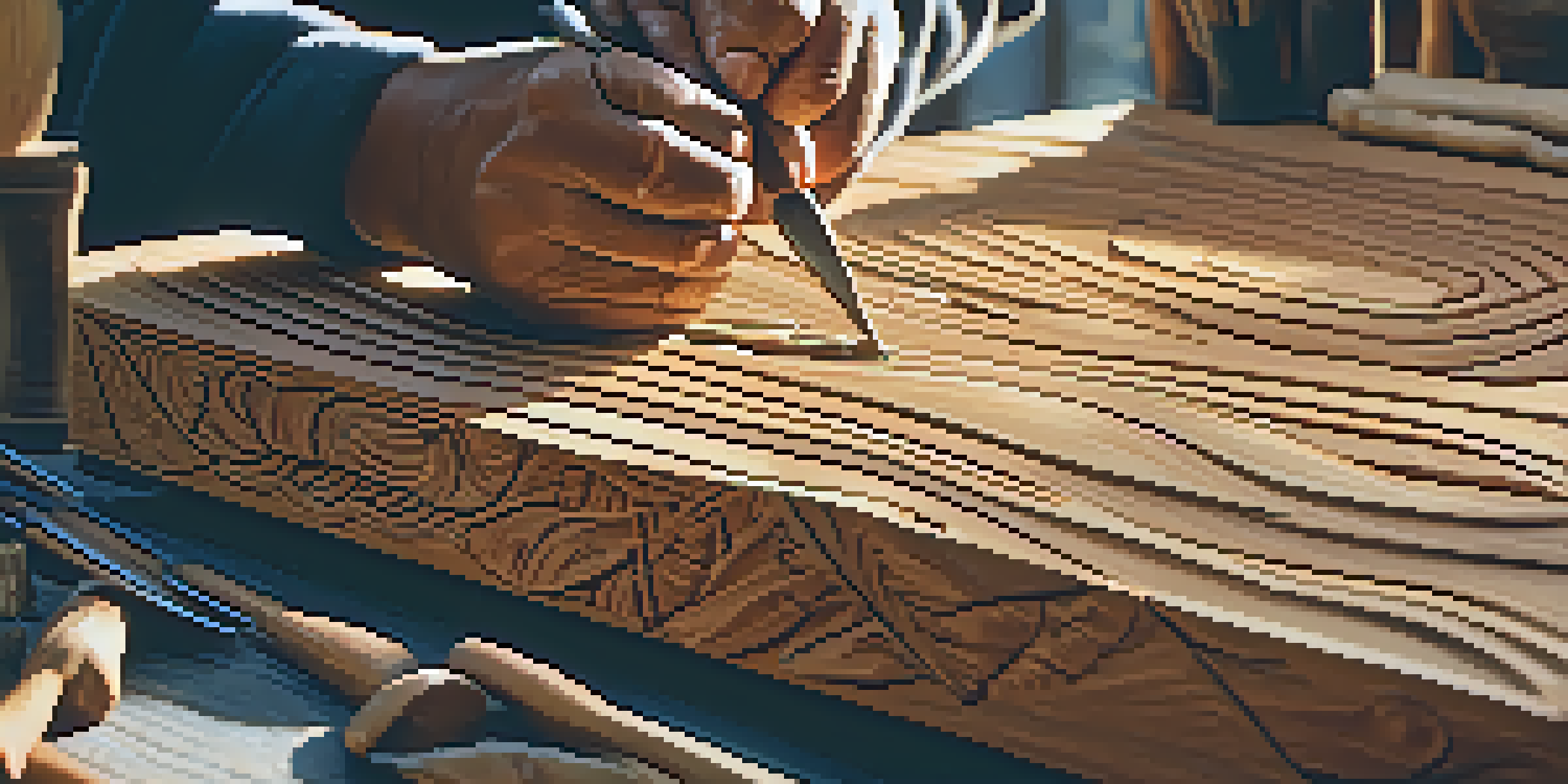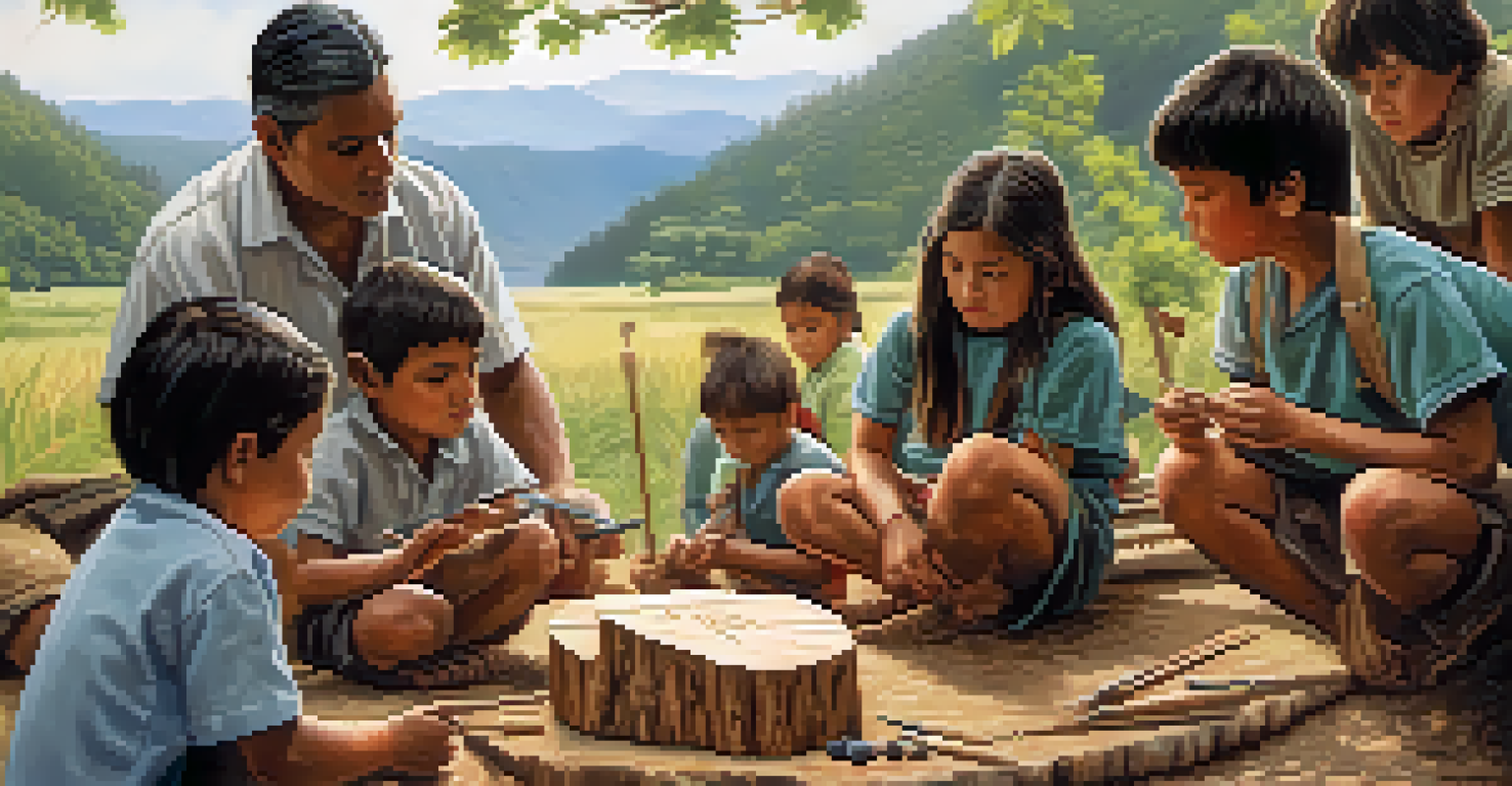Carving in Indigenous Cultures: A Reflection of Ancestral Stories

Understanding Indigenous Carving Traditions
Carving holds a significant place in many Indigenous cultures, serving as a way to express identity and heritage. Each carved piece is not just an object; it's a narrative steeped in tradition and symbolism. From totem poles to intricate masks, the designs often tell stories of creation, ancestors, and community values.
Art is a way of expressing our deepest selves and the stories that shape us.
These artistic expressions are often linked to the natural world, drawing inspiration from animals, plants, and celestial bodies. For example, a carving of a bear can symbolize strength and courage, while a whale might represent wisdom and protection. This intimate connection to nature allows the stories conveyed through carving to resonate deeply with the community.
Understanding these traditions is crucial as they provide insight into the worldview of Indigenous peoples. Each carving is a lesson, a reminder of the past, and an invitation to future generations to preserve and honor their cultural narratives.
Materials and Techniques Used in Carving
The materials used in Indigenous carving often reflect the environment and resources available to each community. Wood, bone, stone, and ivory are commonly utilized, with each medium offering unique characteristics that influence the final piece. For instance, cedar is prized for its workability and durability, making it a popular choice for totem poles and canoes.

Techniques vary widely among different Indigenous cultures, with some employing hand tools while others have adapted modern tools for their artistry. Traditional methods often involve careful planning and a deep understanding of the materials, ensuring that each piece is both functional and a work of art. This combination of technique and material creates a distinct style that is easily recognizable.
Carving as Cultural Expression
Indigenous carving serves as a vital means for communities to express their identity, heritage, and connection to nature.
Moreover, the process of carving is often communal, involving collaboration and mentorship that strengthens community bonds. This sharing of knowledge not only preserves techniques but also fosters a sense of belonging and continuity among generations.
Symbolism and Meaning Behind Carvings
Each carving is imbued with symbolism, often reflecting the beliefs and values of the culture it represents. For example, many Indigenous cultures incorporate spiritual elements into their art, using symbols to convey messages about life, death, and the interconnectedness of all beings. This rich tapestry of meaning makes each piece not merely decorative but profoundly significant.
The act of creation is a powerful form of resistance against cultural erasure.
In many cases, the stories behind the carvings are passed down orally, enhancing the cultural narrative that surrounds them. A carved figure might represent a legendary hero, a creation story, or an important historical event. This oral tradition enriches the experience of viewing the artwork, as it invites the audience to engage with the story behind the piece.
The symbolism found in these carvings serves as a reminder of the lessons and teachings of ancestors. By preserving these stories through art, Indigenous cultures ensure that their histories and values are honored and remembered for future generations.
Carving as a Form of Resistance
In addition to storytelling, carving has historically served as a form of resistance for Indigenous peoples facing colonization and cultural erasure. By continuing the practice of carving, these communities assert their identities and reclaim their narratives. Each carving becomes a statement of existence, a refusal to be forgotten.
Through their art, Indigenous carvers challenge stereotypes and misconceptions, presenting a more nuanced understanding of their cultures. This is particularly important in today's world, where representation matters and authentic voices are vital. Carving allows Indigenous artists to share their truths, fostering a greater appreciation for their heritage.
Symbolism and Storytelling
Each carved piece is rich with symbolism, conveying important cultural narratives and teachings that are passed down through generations.
Moreover, this act of carving can promote healing and resilience within communities. Engaging in traditional practices provides a sense of pride and continuity, reminding individuals of their roots and the strength of their ancestors.
The Role of Carving in Cultural Education
Carving plays a crucial role in cultural education, serving as a tool for teaching younger generations about their heritage. Workshops and gatherings centered around carving provide opportunities for mentorship, where elders pass down their skills and stories. This hands-on learning fosters a deep connection to cultural identity.
In schools and community programs, carving is often integrated into curricula to help students understand the significance of their culture. By engaging with traditional art forms, young people gain a sense of pride in their heritage and learn the importance of preserving their history. This educational aspect ensures that the art of carving continues to thrive.
Additionally, carving can bridge cultural divides, inviting non-Indigenous individuals to learn and appreciate Indigenous stories and perspectives. This exchange promotes understanding and respect, essential elements in fostering meaningful relationships across cultures.
Modern Influences on Indigenous Carving
While rooted in tradition, Indigenous carving has not remained stagnant; it has evolved alongside modern influences and technologies. Many contemporary artists blend traditional techniques with modern aesthetics, creating pieces that resonate with both Indigenous and non-Indigenous audiences. This fusion of old and new reflects the dynamic nature of culture.
Social media and online platforms have also played a significant role in showcasing Indigenous art to a global audience. Carvers can now share their work and stories, reaching people far beyond their local communities. This visibility helps to raise awareness about Indigenous issues and promotes appreciation for their artistry.
Modern Adaptations in Carving
Contemporary Indigenous carvers blend traditional techniques with modern influences, ensuring their art evolves while honoring cultural roots.
However, it's important for modern carvers to maintain the integrity of their cultural expressions. Balancing innovation with tradition ensures that the essence of their stories and heritage remains intact, allowing them to navigate the complexities of contemporary life while honoring their ancestors.
The Future of Indigenous Carving
Looking ahead, the future of Indigenous carving appears promising as younger generations embrace their cultural heritage. With increased access to resources and education, more individuals are exploring carving as a means of artistic expression and cultural connection. This resurgence is vital for the continuity of Indigenous stories and traditions.
Furthermore, collaborations with non-Indigenous artists and institutions can create opportunities for dialogue and mutual learning. By engaging in respectful partnerships, both communities can benefit from shared knowledge and perspectives. This collaborative spirit can lead to innovative projects that celebrate diversity and inclusivity.

Ultimately, the future of Indigenous carving lies in its ability to adapt and thrive while remaining true to its roots. As long as there are stories to tell and traditions to honor, carving will continue to be a powerful medium for expressing the rich tapestry of Indigenous cultures.